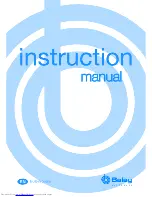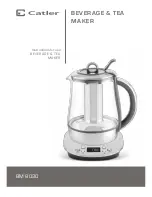
8
Filling the Drying Trays
When loading the food into the trays you can use all of the tray’s surface, but some airflow
must be maintained. Try to place the food in a single layer whenever possible. This is
particularly important with foods like banana slices and pineapple rings and not quite as
important with beans. If some of the pieces come out with too much moisture when you are
finished, one of the reasons is that it might have been covered by other pieces of food.
Dehydration removes the moisture and will cause the food to shrink as it dries. This allows
you to store the same amount of food in a smaller space, but it also means that as the food
shrinks during the drying process, smaller pieces can fall through the holes of the drying
trays. To prevent this, particularly when drying chopped or shredded foods, line the trays
with mesh tray Inserts before laying out the food. Chopped food should not be spread thicker
than 3/8 inch. Use a fork to expose the mesh tray insert in several places to provide proper air
circulation.
If you do not have mesh tray inserts available, use nylon netting, needlepoint canvas,
cheesecloth or similarly, coarse woven fabric. When lining the tray be sure to cut an opening
for the tray’s center hole, The fabric should be food safe, allow air to pass through it, and it
must be laundered before being used. Use care when choosing fabric as sticky foods may not
be able to be easily removed and particles from the fabric may stick to the food pieces.
It may be necessary to stir the finely chopped food once or twice during dehydration to
ensure even drying of all the pieces. To do so, turn the machine off, unplug it, remove the
trays, stir, then reassemble and restart the machine according to the instructions.
Prevent Dripping
Some foods such as very ripe tomatoes and citrus or sugared fruits may drip. If too much
liquid drips into the bottom of the unit it can be damaged necessitating service. Additionally,
the dripping from a tray above can change the flavour of different foods on lower trays.
To help lessen dripping after placing food on drying trays and before placing them on the
dehydrator base, tap the tray firmly downward on a towel laid on the counter top a few times
to remove excess moisture.
To catch any remaining dripping during dehydration that may occur with very moist foods,
use fruit leather sheets placed on the bottom two trays. Alternate the sheets on one half of
the two trays (i.e.. the left side of the first tray and the right side of the second tray). Then
place these two bottom trays on the dehydrator base before placing the remaining trays with
the food to be dried above them. When rotating trays, wipe the fruit leather sheets, but leave
these two trays at the bottom of the stack of trays. When the food becomes dry enough so
that it is no longer dripping, remove the fruit leather sheets from the two bottom trays to
enhance air flow.
Do not use wax paper in place of the fruit leather sheets as the wax on the paper will melt
at dehydration temperatures which can taint the food or damage the dehydrator. Always
remember to leave the center hole of each tray uncovered.









































